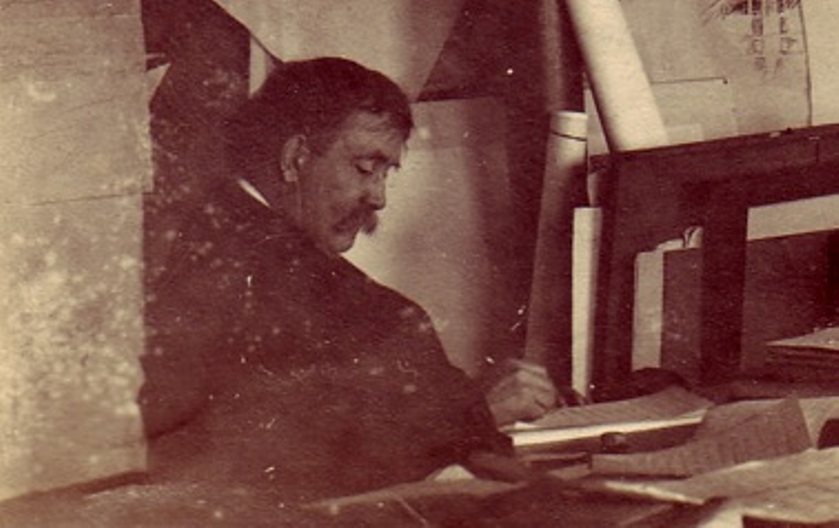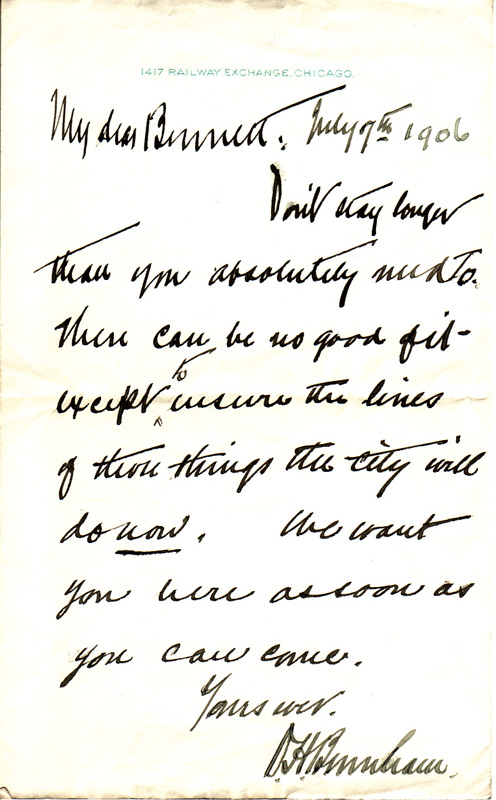It’s a tantalizing image --- Daniel Burnham writing on a long pad of paper with a page of completed manuscript sitting atop a pile of books and papers on the table to his right.

Candid photos of Burnham are rare, and no photo of him writing the Plan of Chicago is known to exist.
But could that be what this photo has captured? Is this the great planner in the act of handwriting the 310-page draft of the Plan that now resides in the archives of the Art Institute of Chicago?
The Plan, published on July 4, 1909 and commonly known as the Burnham Plan, was a seminal document in urban history. Not only did it act as the blueprint for a transformation of Chicago and its region, but it was instrumental in establishing worldwide the idea that planning was essential for the efficient growth of cities.
Discovering a photo of Burnham writing the Plan would be the equivalent of stumbling across an image of Carl Sandburg composing his poem “Chicago” in 1916 or of Pablo Picasso painting “Les Demoiselles d'Avignon” in 1907.
"We've got stuff nobody's seen."
Long buried in a rich cache of personal memorabilia that belonged to Edward H. Bennett, the co-author of the Plan, the photo was discovered last October by Arthur Miller, archivist and librarian for special collections at Lake Forest College.
He stumbled across it during a cursory examination of Bennett’s memorabilia at the Lake Forest home of Bennett’s grandson, Edward Bennett III.
“Do you have any more?” an astonished Miller asked. And, when he went home that night, he told his wife, “We’ve got stuff nobody’s seen.”
A month later, Bennett’s grandson donated the foot-tall pile of documents, letters and photos to the Lake Forest College library. A description of the collection can be found at the library’s website.
Mary Woolever, the art and architecture archivist at the Art Institute, says there’s no way to determine whether the photo shows Burnham writing his draft of the Plan or something else. Yet, she notes the photograph is of interest because there are relatively few images of the private Burnham.
Her Art Institute colleague, Nathaniel Parks, an assistant archivist who has worked extensively with the Burnham manuscript, says, "There is no way to conclusively determine whether the papers in the photo are the Plan."
Nonetheless, he notes that there are several aspects of the pages in the photo --- the size of the paper, the way they're numbered and the way Burnham's writing extends nearly to the top of the page --- that are consistent with the handwritten draft.
Carl Smith, the Northwestern University literature and history professor who wrote “The Plan of Chicago: Daniel Burnham and the Remaking of the American City,” says the photo appears to have been taken in the 18th floor rooftop studio at the Railway Exchange Building (now the Santa Fe Building) which was the workshop for those preparing the Plan.
“He is obviously writing something on sheets of paper that look very much like those he used to write his handwritten draft of the Plan,” Smith says.
Whether Burnham is writing the Plan or not, Smith says the image “is the only photo of its kind that I have seen.”

"We want you here"
In addition to the photo of Burnham writing whatever it is he’s writing, the treasure trove of Bennett memorabilia contains 15 handwritten letters from Burnham to Bennett, including one written on July 7, 1906, the day after accepting the job to oversee the Plan.
In a quick summons to Bennett who was in San Francisco, Burnham wrote, “Don’t stay longer than you absolutely need to…We want you here as soon as you can come.”

Miller notes that, because of fears for his health, Burnham wanted Bennett in place to head the project if need be.
In 1906, Chicago business leader Charles Dyer Norton went to Burnham to ask him to oversee the Plan, only to be told by the despondent architect that his doctors had given him at most only three more years to live.
“There was an embarrassed and painful silence,” Norton later wrote, “and then I blurted out, ‘But Mr. Burnham, that is just time enough; it will take only three years.’ Burnham looked startled, then he broke into a laugh and said: ‘You’re right. I will do it.’ ”
At the library website, Miller writes, “Burnham indeed lived six more years. But concern about his health would have contributed to his urgent wish to pull Bennett back to Chicago to be his understudy, in effect, as well as right-hand man on the plan.”
(NEXT: Other photos in the Bennett collection.)
For a print-friendly version of this post, go here.
Blog Categories
- art (14)
- civic engagement (17)
- culture (16)
- future (26)
- green legacy (15)
- history (26)
- pavilions (4)
- schools (8)
- transportation (7)
